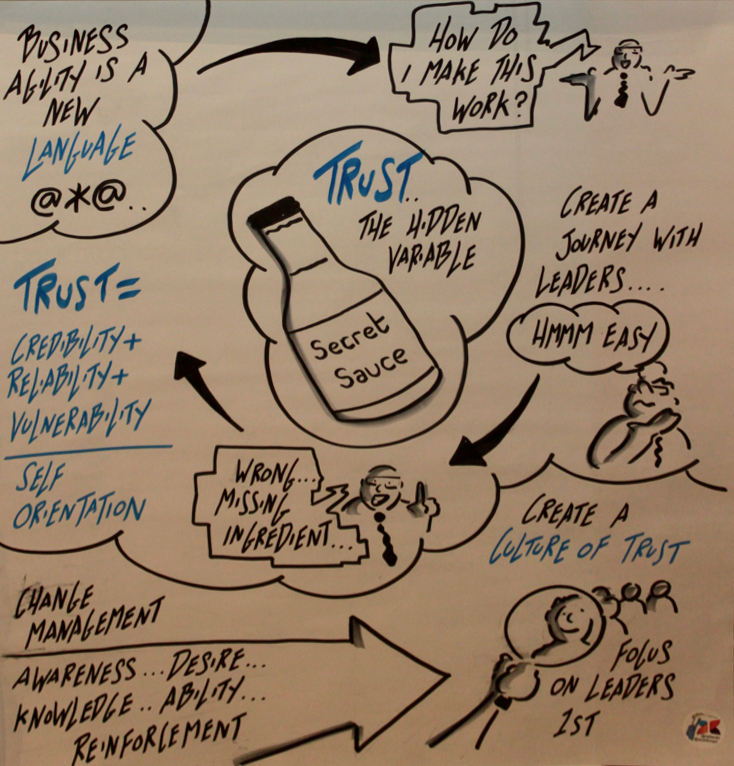Thank you! As the last speaker, I’m excited to share my story and experience with the Business Agility Conference. The secret sauce is this—last year, I applied to be a speaker. Chris Edwards, who worked at the same company at the time, sent me an email rejecting my application. That moment made me realize something—I thought I understood business agility, but in reality, I had just discovered a treasure. A new world. A whole new language.
My focus has always been on organizational development and leadership, not so much on the tech side. I showed up to the conference last year in New York, eager to learn, but I felt completely out of place. I was surrounded by amazing minds, yet I was a different kind of beast. How could I take what I learned back to my organization? As I listened to the talks, one in particular resonated with me—the concept of flattening organizations. Suddenly, I could see through the matrix.
As I returned home, I found myself at a crossroads—do I take the blue pill or the red pill? How do I, as an organizational development leadership coach, make this work? Then it hit me—I could incorporate these concepts into smaller teams, making them more responsive, helping them define their own ways of working. The possibilities exploded.
A Call to Transformation
Then I got a phone call. A company reached out, asking for help with their transformation. They told me, "We're reorganizing into feature teams and tribes, and we need you to work with our leaders." That was my space, my expertise. I was excited.
I thought I had it all planned out. I’d focus on leadership, while the teams simultaneously went through Scrum and Agile training. It seemed perfect. I assumed that by teaching leaders to create a common language, they would naturally come together as a team. But the truth was, trust didn’t exist within the team.
Understanding Trust
One of the core leadership models I use is Patrick Lencioni’s Five Dysfunctions of a Team. At the foundation of it all is trust. Without it, leadership fails. I define trust as:
- Credibility + Reliability + Vulnerability
- Divided by Self-Orientation
Credibility and reliability come with time. The two variables leaders can control most are vulnerability and self-orientation. Self-orientation refers to how much a leader focuses on themselves rather than others. If I'm nervous about speaking right now, my self-orientation is high. If I focus on serving you, it’s low.
Vulnerability sounds like:
- "I was wrong."
- "That idea is better than mine."
- "I need your help."
- "I screwed up."
- "I don’t know."
Now, how often do you hear executives say these things? Not often. Yet, vulnerability-based trust is what creates strong teams.
The Problem with a Lack of Trust
In this particular transformation, a team member suggested a new idea during a sprint. The leader shut it down immediately: "No, we’re not doing that." Conversation over. No discussion, no feedback, no retrospectives—or if they did have retrospectives, they were superficial. "Any comments on how we could improve?" Silence.
Sound familiar? The best methodology and training mean nothing if trust is absent. This company spent thousands of dollars on Agile trainers, yet the transformation was a non-starter. Why? Because the culture was one of distrust.
What Happens Without Trust?
When trust is absent, teams operate in fear. Employees don’t speak up. They avoid conflict. They disengage. A recent Gallup survey found that only three out of ten employees strongly agree that their opinion counts at work. That’s a trust issue.
Without trust, transformation stalls. Leaders wonder, "Why isn’t my team embracing this change?" Of course, they see the benefits, but trust isn’t a cognitive process—it’s emotional. Leaders struggle because change makes them feel vulnerable. They worry: "Will this expose my weaknesses?" "Will this make me look incompetent?"
Focusing on the Leader
I told the HR business partner, "I’m not doing this. I won’t train the team. I’ll work with the leader." Why? Because I’ve been through this before. Teams love training. They soak it up. But at the end of the session, someone always says, "I wish my leader was here to hear this."
I used the ADKAR change management model, which focuses on the people side of change:
- Awareness
- Desire
- Knowledge
- Ability
- Reinforcement
The leader in this transformation was resistant. He had past success using traditional methods and wasn’t convinced Agile was necessary. While his teams trained in Agile, he disengaged. When team members approached him, he stopped asking questions and started making demands.
The Hard Truth
Ultimately, this leader made a decision—to bury his head in the sand. He chose not to engage in the transformation. Despite clear data, support, and a roadmap for change, he opted out. Why? Because building trust takes time, and time requires effort.
No training, no methodology, no framework will work if trust isn’t there. Without trust:
- Retrospectives get skipped.
- Stand-ups become meaningless.
- Feedback disappears.
Lessons Learned
My biggest lesson? Start with the leaders. If a company asks you to help with Agile transformation, your first question should be: Who goes first? If they say, "Let’s train our frontline employees first," know that transformation will fail unless leadership is on board.
Months later, I got a call from the same company. "We need conflict resolution training," they said. My response? "Tell me about trust." Because without trust, conflict resolution is just a temporary bandage.
Final Thought
Build trust first. Or second. Or third. But make it a priority. It is the secret sauce that moves organizations forward.
Tomorrow, in the open space session, we’ll ask: What’s first for you? How do you get your leaders on board? How do you build trust in your teams?
And that’s where transformation begins.




